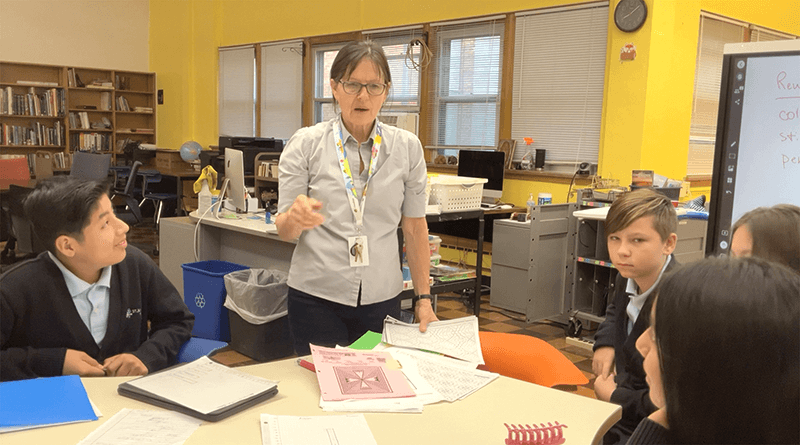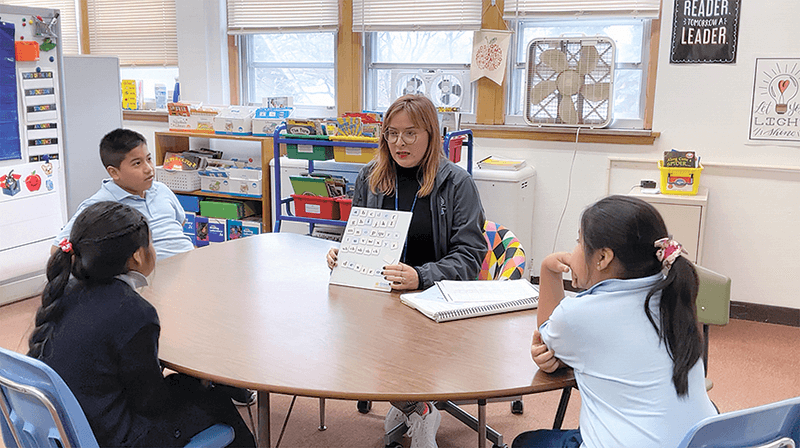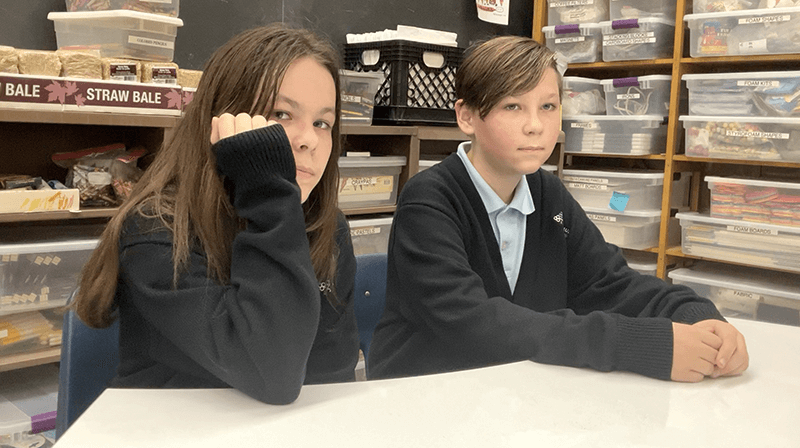Last fall St. John Paul II Catholic School debuted a special program for young learners new to its community. Aptly named the Newcomer Experience, it provides academic structure and specialized learning opportunities for immigrant and refugee children new to the United States.
The Kindergarten through 8th grade school at St. John Paul II has been welcoming nonnative English speakers for decades. Over the years, hundreds of Polish immigrants settled in Northeast Minneapolis, raising families and building businesses that are part of its foundation.
Today, most of the new arrivals to JPII come from Ecuador, many joining family members who already live here and belong to the school and parish. This school year, there are also four children who arrived from Ukraine as refugees.
Tricia Menzhuber is the principal, and a math and science teacher, at JPII. During her five years at the school, she’s seen enrollment of ESL (English as a Second Language) students increase substantially.
“We’ve always had welcome plans in place,” said Menzhuber, “but we knew we needed to scale up for 2022. My first year here we had one new ESL student; the next year, two. This year we have 30!”
Of the nearly 180 students enrolled at JPII, more than 75% are nonnative speakers. “Our kindergartners come in and we’re often their first English experience or first school experience,” said Menzhuber. “We’re ready for that. With older ESL children who are past basic phonics and beginning reading, it can be more difficult to help them jump into grade-level rigor.”
Structured for second through eighth graders, the Newcomer Experience at JPII is based on the U.S. Department of Education’s recommendations for school districts that serve immigrant children. Its Newcomer Guide to Schools asks that every district have a plan to welcome immigrant children.
“Those plans are as distinct as their districts,” offered Menzhuber. “Some create a special school experience that allows students to graduate out of it and into the mainstream classroom. At JPII, we’re a small school, and we don’t have the same resources as larger institutions to create a school-within-a-school.”
The Newcomer Experience model created by Menzhuber and her colleagues is a hybrid combination of regular classroom learning with smaller, break-out sessions. Lower grades receive “small group time,” and middle-schoolers have “specials” as part of their school day.
“Students spend time in their homeroom, making friends,” said Menzhuber, adding with a laugh, “To provide directed language and cultural support, we hijacked English and reading!”
Menzhuber says the children learn conversational English easily, and states the goal: “Within the school year, every one of our Newcomers is speaking English, understandably, to a teacher.”
Federal funding provides JPII with additional staff support. Newcomers leave homeroom and spend time with an ESL teacher and a Title I teacher to learn reading and phonics. The school has also been able to hire a full-time student counselor.
JPII has open enrollment, which means kids can enter anytime during the school year. Menzhuber said one of the biggest challenges educators face is acclimating new students – who are at different developmental stages – into their own grades. “We have to meet them where they are academically and find a balance between getting them up to speed, while keeping other students engaged.”
During the week, middle schoolers who are part of the Newcomer program take enrichment classes that are taught in their native language. “We’re not pushing English right away, at that level of middle school science. We want students to learn the material so that educators can build on academic understanding.”
Menzhuber said technology plays an important role. “We have digital translator tools, keyboard overlays and one-way translator apps on tablets that allow students to hear content in their native language. While they can’t tell it back to us that way, we have other tech tools like Classkick for translation. Students work through assignments at their own pace, and teachers can observe progress and provide feedback in real time.”
As students progress academically, they build confidence and learn to take risks. One young girl, Giselle, a third grader, arrived at JPII last October from Ecuador. A quick learner, she soon began helping others in the classroom, and would often ask her teacher for learning materials to take home on the weekends. Recently, Giselle read a Sunday Mass – in English – to the JPII parish.
Fritson, a second grader, arrived in Minnesota from Ecuador last December. In January he enrolled in the Newcomer Experience and within two weeks was at the board demonstrating his math skills during the solve-and-share part of class. “That doesn’t say something about math or language,” said Menzhuber. “It says something about the comfort he feels in that classroom to take a risk, and the community that has been fostered.”
Building confidence and fostering relationships is key. “We identify family reunification as a key goal. Many new students are dealing with social and emotional challenges that are part of their journey to the United States,” she said. When family members arrive in the U.S. at different times, it’s a shakeup for the family; it’s traumatic. Even under good circumstances, there’s an adjustment period and redefining family roles. That’s where Silvia comes in.”
Silvia Ochoa is a young Latina with a background in social work. She’s an important liaison between students and teachers as the full-time student counselor at JPII. Ochoa helps Newcomers learn social and emotional skills that build confidence and promote learning in their new environment.
“Most of the new kids experience trauma,” she said, “But even if they don’t, we’re here to make sure everyone feels safe at school and that they’re able to connect with others. Creating a safe and welcoming space for them and their families and meeting them where they’re at,” is the focus.
Ochoa also does regular check-ins with the kids – in the halls, via text, in person. She says communication and representation are key. “Seeing someone who looks like them is very important.”
When Ochoa meets with students, they all speak Spanish to give the kids a mental break. But as the year progresses, she introduces more and more English into their conversations.
“Code switching is really hard,” explained Menzhuber. “That’s hearing something in English, translating it to Spanish in the brain, thinking about it in Spanish, and then communicating it back in English – that’s difficult. Kids still need that mental language break.”
Four Ukrainian children enrolled in the JPII Newcomer Experience this year. Menzhuber said there are language resources for them, too.
“The Ukrainian kids speak Polish,” she said, “and we’re the Polish parish. We have a Polish-speaking priest who does check-ins and he’ll hang out and talk to them. We also have a math tutor who speaks Russian. He saw another story on our program and contacted the school to see how he could help. There’s also a Ukrainian substitute teacher.”
As the school year winds down, Menzhuber is already thinking about next year’s program and encourages other schools to structure Newcomer Experiences unique to their communities.
When asked by peers to share JPII’s best practices, she chuckled and said she gets a little bit annoyed. “I hear people say, ‘You should check out JPII – they’re set up for this.’ That’s baloney! We weren’t set up to do anything … the kids were just coming and we said ‘welcome.’
“Any school can do that. You are called to do this work and you have a great community to welcome them. You can do this. It starts with one student. We’re all gonna get better at this.”
Newcomer Experience at St. John Paul II provides academic structure and specialized learning opportunities for immigrant and refugee children new to the United States. Most of JPII’s newcomers came to the U.S. from Ukraine or Ecuador. Leaving or reuniting with family requires emotional adjustment, and school staff can help. (Photos by Rob Hahn, Ascension Catholic Academy)


